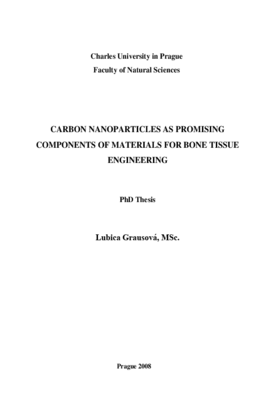Carbon nanoparticles as promising components of materials for bone tissue engineering
Uhlíkové nanočástice jako nadějný materiál pro inženýrství kostní tkáně
dizertační práce (OBHÁJENO)

Zobrazit/
Trvalý odkaz
http://hdl.handle.net/20.500.11956/14002Identifikátory
SIS: 112507
Kolekce
- Kvalifikační práce [19614]
Autor
Vedoucí práce
Oponent práce
Mikšík, Ivan
Balík, Karel
Fakulta / součást
Přírodovědecká fakulta
Obor
-
Katedra / ústav / klinika
Katedra biochemie
Datum obhajoby
9. 12. 2008
Nakladatel
Univerzita Karlova, Přírodovědecká fakultaJazyk
Angličtina
Známka
Prospěl/a
Souhrn Nanotechnologie v tkáňovém inŽenýrství se stala v posledních letech důleŽiýmpředrnětern výzkumu Pro regeneraci tkání se studují různét1p1 nanostrukturovaných materiálů. Důvodem vyuŽití těchto rnateriálťr v tkáňovém inŽenýrství je jejich schopnost napodobovat přirozenou extracelu|ární matrix a tímpodporovat adhezi, růst a diferenciaci buněk. Náš ýzkum by| zaměřen na v|iv vrstev fullerenů, kompozitů uh|íkoqýclr nanotub a syntetického terpolymeru a vrstev rranokrystalického diamantu na adhezi, růst,životaschopnost a diferenciaci lidských osteoblastů linie MG 63. KaŽdý z těchto materiálů podporoval kolonizaci svého povrclru buňkami. Na kontirruálrrích vrstvách fu1lerenů Coo, deponovanýclr na uhlíkové kompozity s uhlíkovou matricí vyáuženou uhlíkovými vlákny byla sice populačníhustota buněk nižšív porovnání s uhlíkov'ým kompozitem bez fullerennílro filmu, ale tyto buriky dosahovaly větší adhesní plochy, coŽ bylo dale spojeno s dobře q'vinuým beta- aktinov'ým cýoskeletem a foká|ními adhezními plaky s obsahem vinkulinu. Na kompozitech uhlíkových nanotub a terpolymeru složenélioz po|ýetrafluoroeýlenu, po|ypropylenu a poly.viny|difluoridu' byla adhese buněk, jejich rozprostření, tvorba fokálníclr adlresních plakůa aktinového cytoskeletu, viabilita a buněčnýrůstznačnězlepšena v porovnání s čisýmterpolymerem....
Recently, nanotechnology in tissue engineering has become a very irnportant field of study. Many different materials of nanoscale roughness have been studied for their potential use in the regeneration of various tissues. The reason is that nallostructured materials imitate the architecture of natural extracellular matrix and thus support cell adhesion, growth and differentiation. Our investigations were focused on the influence of fullerene layers, carbon nanotube-terpolymer composites and nanocrystalline diamond layers on the adhesion. growth and differentiation of human osteoblast-like MG 63 cells. Each of these materials supported colonization with cells. On continuous fullerene C6s layers, deposited on composites with the carbon matrir reinforced with carbon fibres, the cell population density was lower than on non-coated composites. but MG 63 cells were well-spread w'ith rvell-developed vinculin-containing focal adhesiort plaques and a beta- actin cy'toskeleton. On contposites of carbon naliotubes u ith a terpolymer of poll.tetrafluoroethvlene. poly propy lene and polyvinyldifluoride, the adhesion, spreading. formation oť tbcal adhesion plaques and actin cytoskeleton, viability and cell grouth u ere markedly improved in comparison with pure terpolymer. At the same time, these cells did not...
